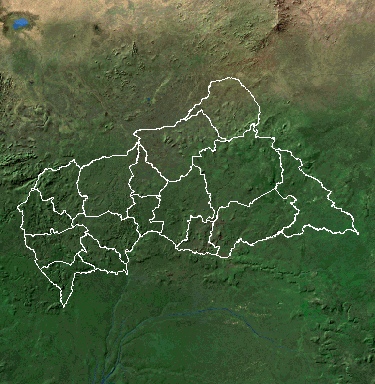|
|
 |
| |
back to top | ||
|
|
|||
 |
Population. Still found in the south-eastern area of the country, bordering Sudan and in the southern middle of the country, bordering Democratic Republic of Congo. A small population still existed in Saint Floris National Park boarding Chad and the hunting domains in the north. Principal Threats. Extensive poaching and limited prey species. |
||
|
|
|||
|
|
|||
|
Background: The former French colony of Ubangi-Shari became the Central African Republic upon independence in 1960. After three tumultuous decades of misrule - mostly by military governments - civilian rule was established in 1993 and lasted for one decade. President Ange-Felix PATASSE's civilian government was plagued by unrest, and in March 2003 he was deposed in a military coup led by General Francois BOZIZE, who established a transitional government. Though the government has the tacit support of civil society groups and the main parties, a wide field of candidates contested the municipal, legislative, and presidential elections held in March and May of 2005 in which General BOZIZE was affirmed as president. The government still does not fully control the countryside, where pockets of lawlessness persist. |
|||
| back to top | |
|
|
|
|
Area: total: 622,984 sq km; land: 622,984 sq km; water: 0 sq km Climate: tropical; hot, dry winters; mild to hot, wet summers Terrain: vast, flat to rolling, monotonous plateau; scattered hills in northeast and southwest Natural resources: diamonds, uranium, timber, gold, oil, hydropower Land use: arable land: 3.1%; permanent crops: 0.15%; other: 96.75% (2005) Irrigated land: 20 sq km (2003) Natural hazards: hot, dry, dusty harmattan winds affect northern areas; floods are common Environment - current issues: tap water is not potable; poaching has diminished the country's reputation as one of the last great wildlife refuges; desertification; deforestation Environment - international agreements: party to: Biodiversity, Climate Change, Desertification, Endangered Species, Ozone Layer Protection, Tropical Timber 94; signed, but not ratified: Law of the Sea |
|
| |
back to top | |
|
Population: 4,303,356 Age structure: 0-14 years: 41.9% (male 907,629/female 897,153); 15-64 years: 53.9% (male 1,146,346/female 1,173,268); 65 years and over: 4.2% (male 71,312/female 107,648) (2006 est.) Median age: total: 18.4 years; male: 18 years; female: 18.8 years (2006 est.) Population growth rate: 1.53% (2006 est.)
|
|
|
|
Infant mortality rate: total: 85.63 deaths/1,000 live births; male: 92.44 deaths/1,000 live births; female: 78.61 deaths/1,000 live births (2006 est.) Life expectancy at birth: total population: 43.54 years; male: 43.46 years; female: 43.62 years (2006 est.) Total fertility rate: 4.41 children born/woman (2006 est.) HIV/AIDS - adult prevalence rate: 13.5% (2003 est.) HIV/AIDS - people living with HIV/AIDS: 260,000 (2003 est.) HIV/AIDS - deaths: 23,000 (2003 est.) Ethnic groups: Baya 33%, Banda 27%, Mandjia 13%, Sara 10%, Mboum 7%, M'Baka 4%, Yakoma 4%, other 2% Religions:
indigenous beliefs
35%, Protestant 25%, Roman Catholic 25%, Muslim 15% Languages: French (official), Sangho (lingua franca and national language), tribal languages Literacy: definition: age 15 and over can read and write; total population: 51%; male: 63.3%; female: 39.9% (2003 est.) |
||
| |
back to top |
|
Data Code: CF Government type: republic Independence: 13 August 1960 (from France) Legal system: based on French law Political pressure groups and leaders: NA |
|
| back to top | |
|
Economy - overview: Subsistence agriculture, together with forestry, remains the backbone of the economy of the Central African Republic (CAR), with more than 70% of the population living in outlying areas. The agricultural sector generates more than half of GDP. Timber has accounted for about 16% of export earnings and the diamond industry, for 40%. Important constraints to economic development include the CAR's landlocked position, a poor transportation system, a largely unskilled work force, and a legacy of misdirected macroeconomic policies. Factional fighting between the government and its opponents remains a drag on economic revitalization. Distribution of income is extraordinarily unequal. Grants from France and the international community can only partially meet humanitarian needs. GDP - real growth rate: 3% (2006 est.) GDP - composition by sector: agriculture: 55%; industry: 20%; services: 25% (2001 est.) Labor force: NA Unemployment rate: 8% (23% for Bangui) (2001 est.) Population below poverty line: NA% |
|
|
Agriculture - products: cotton, coffee, tobacco, manioc (tapioca), yams, millet, corn, bananas; timber Industries: gold and diamond mining, logging, brewing, textiles, footwear, assembly of bicycles and motorcycles Industrial production growth rate: 3% (2002) Exports: $131 million f.o.b. (2004 est.) Exports - commodities: diamonds, timber, cotton, coffee, tobacco Exports - partners: Belgium 34.9%, France 9.6%, Spain 8.7%, Italy 8.1%, China 7.1%, Indonesia 6.3%, Democratic Republic of the Congo 4.7%, US 4.5%, Turkey 4.5% (2005) |
|
|
Imports: $203 million f.o.b. (2004 est.) Imports - commodities: food, textiles, petroleum products, machinery, electrical equipment, motor vehicles, chemicals, pharmaceuticals Imports - partners: France 16.6%, Netherlands 10.3%, Cameroon 9.7%, US 7.3% (2005) Currency (code): Communaute Financiere Africaine franc (XAF); note - responsible authority is the Bank of the Central African States Exchange rates: Communaute Financiere Africaine francs (XAF) per US dollar - 527.47 (2005), 528.29 (2004), 581.2 (2003), 696.99 (2002) |
|
| |
back to top | ||
|
Telephone system: general assessment: fair system; domestic: network consists principally of microwave radio relay and low-capacity, low-powered radiotelephone communication; international: country code - 236; satellite earth station - 1 Intelsat (Atlantic Ocean) Radio broadcast stations: AM 1, FM 5, shortwave 1 (2002) Television broadcast stations: 1 (2001)Internet country code: .cf Internet hosts: 10 (2006) Internet users: 9,000 (2005) |
|||
|
|
|||
|
|||
|
Marker L., Malouf J. and Malouf A. 1999. Appendix 2: The status of the wild cheetah in its range countries. In: 1999 International Cheetah Studbook. http://www.cia.gov/cia/publications/factbook/geos/ao.html (last update on 10 January, 2006) http://www.lib.utexas.edu/maps/map_sites/country_sites.html#benin http://www.lonelyplanet.com/mapshells/africa/central_african_republic/central_african_republic.htm
|




